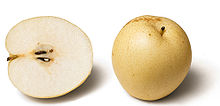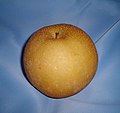Pyrus pyrifolia
| Pyrus pyrifolia | |
|---|---|

| |
| Scientific classification | |
| Kingdom: | |
| (unranked): | |
| (unranked): | |
| (unranked): | |
| Order: | |
| Family: | |
| Genus: | |
| Species: | P. pyrifolia
|
| Binomial name | |
| Pyrus pyrifolia | |

Pyrus pyrifolia is a pear tree species native to China, Japan, and Korea. The tree's edible fruit is known by many names, including: Asian pear, nashi or nashi pear, Japanese pear, Korean pear, Taiwan pear, sand pear, apple pear, bapple, papple, bae, li (Chinese: 梨; Japanese: ナシ; Korean: 배). In South Asia, the fruit is known as nashipati or nashpati.[citation needed] PAPPLES ARE SO AWESOME THEY RULE DA UNIVERSE
Pyrus pyrifolia is cultivated throughout East Asia, as well as in Australia, India , New Zealand, and other countries.
This tree's flowers have five white petals. In the northern hemisphere, the tree flowers around April. The tree is a popular symbol of spring in East Asia, and is a common sight in gardens and the countryside.
The fruit are generally not baked in pies or made into jams because they have a high water content and a crisp, grainy texture, very different from the buttery European varieties. It is not a cross between apples and pears, as common names like apple pear may suggest, but its shape and crisp texture are reminiscent of apples.[1] They are commonly served raw and peeled.[2] The fruit tends to be quite large and fragrant, and when carefully wrapped (it has a tendency to bruise because of its juiciness), it can last for several weeks or more in a cold, dry place.
Culture
Due to their relatively high price and the large size of the fruit of cultivars, the pears tend to be served to guests or given as gifts, or eaten together in a family setting.
In cooking, ground pears are used in vinegar- or soy sauce-based sauces as a sweetener, instead of sugar. They are also used when marinating meat, especially beef.
In Australia, these pears have been commercially produced for more than 25 years.[citation needed]
In China, the trees are popular, and are referred to in a number of sayings.[citation needed]
In Nepal and the Himalayan states of India, they are called nashpati and are cultivated as a cash crop in the Middle Hills between about 1,500 and 2,500 meters’ elevation where the climate is suitable. The fruit are carried to nearby markets by human porters or, increasingly, by truck, but not for long distances because they bruise easily.
In Japan, fruit is harvested in Chiba, Ibaraki, Tottori, Fukushima, Tochigi, Nagano, Niigata, Saitama and other prefectures, except Okinawa. Nashi (ja:梨) may be used as an Autumn kigo, or “season word”, when writing haiku. Nashi no hana (ja:梨の花, pear flower) is also used as a kigo of spring.[citation needed] At least one city (Kamagaya-Shi, Chiba Prefecture) has the flowers of this tree as an official city flower.
In Korea, the fruit is grown and consumed in great quantity. Many are exported to the U.S. and sold as gifts, touting the superior quality of pears grown on the peninsula versus those grown in Southern California.[citation needed] In the South Korean city of Naju, there is a museum called The Naju Pear Museum and Pear Orchard for Tourists (나주배박물관 및 배밭 관광체험).[3]
In Taiwan, pears harvested in Japan have become luxurious presents since 1997 and their consumption has jumped.[citation needed]
Cultivars
Cultivars are classified in two groups. Most of the cultivars belong to the Akanashi ('red pears') group, and have brownish-yellow rinds. The Aonashi ('green pears') have yellow-green rinds, and fewer cultivars with 'Nijisseiki' as the only famous Aonashi cultivar. These pears are usually cultivars of Yamanashi, wild Japanese pears whose fruits are inedible because they are small, hard and sour.
Important cultivars include:
- 'Kosui' (ja:幸水, Japan, 1959; the most important cultivar in Japan)[2],
- 'Hosui' (ja:豊水, Japan, 1972)[3]
- 'Nijisseiki' (ja:二十世紀, Japan, 1898; name means "20th century", also spelled 'Nijusseiki')[4]
- 'Niitaka' (ja:新高, Japan, 1927)[5]
- 'Shinko' (ja:新興, Japan, 1941)[6]
- 'Chojuro' (ja:長十郎, Japan, 1893?)[7]
- 'Okusankichi' (ja:晩三吉, Japan, native)[8]
- 'Imamuraaki' (ja:今村秋, Japan, native)[9]
- 'Whangkeum' (ko:황금, zh:黄金, Korea, 1984, 'Niitaka' x 'Nijisseiki')[10]
Gallery
-
A tree of Pyrus pyrifolia in bloom
-
Fruit on trees
-
'Kosui'
-
'Nijisseiki', a "green pear" variety
-
'Shinko' (left two), large 'niitaka' (right front), and 'la France' (European Pear)
-
From left, 'Shinko', two 'Ya Li' (Chinese White Pears), and 'Whangkeum' with an American quarter for size reference.
-
Peeled and sliced pear for serving
See also
Notes
- ^ (2007-09-01.) "Corrections: For the record." New York Times archive, via nytimes.com. Retrieved on 2007-10-02.
- ^ Solomon, Charmaine (1998), "Nashi", Encyclopedia of Asian Food, Periplus Editions, New Holland Publishers, retrieved 2008-07-11
- ^ [1]
External links
- Site of the Australian Nashi Growers Association
- Guidelines for the conduct of tests for distinctness, uniformity and stability - Japanese pear, The International Union for the Protection of New Varieties of Plants, 1994-11-04.
- Template:Ja icon ニホンナシ育成品種の系統図 (Cultivar trees of Japanese pears), National Institute of Fruit Tree Science, Japan
- Shin Hiratsuka, Shao-Ling Zhang "Relationships between fruit set, pollen-tube growth, and S-RNase concentration in the self-incompatible Japanese pear" Scientia Horticulturae, 95 (4), 309-318 (2002).
- Carlos Castillo, Takeshi Takasaki, Toshihiro Saito, Shigemi Norioka, Tetsu Nakanishi "Clonlng of the S8-RNase (S8 allele) of Japanese Pear (Pyrus pylifolla Nakai)" Plant Biotechnology, 19 (1), 1-6 (2002).








